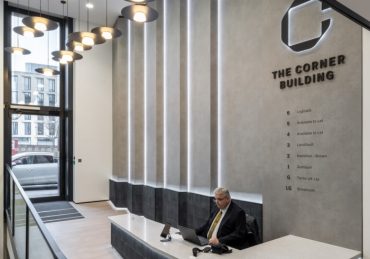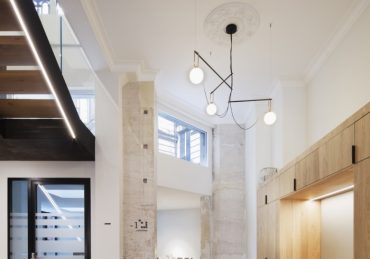Building Your Dream Home – Part 3
| February 11, 2018Building Your Dream Home – Part 3
Exterior Framing Continues
With the home’s sub-floor down and the exterior walls framed and up, the framing crew was on to the roof. Though the roof was rather simple in structure with just a 12/12 pitch and no valleys it was a significant framing undertaking due to just the size and height of it. The house was 32 feet wide by 44 feet in length, and the exterior side walls stood 11 feet tall in the great room. This exterior wall height of 11 feet translated into a roof ridge that was 27 feet off the floor of the great room. Consequently staging was required to install the ridge pole and roof rafters. In addition, since the span from the top of the walls to the ridge was so long, heavy 2x12s were required for the roof rafters. Within a week, however, the team had completed the installation of the roof rafters and the house began to take on real shape.
I should comment briefly about the sub-floor and exterior walls before I move on.
I decided on using ¾” tongue and groove plywood for the sub-flooring rather than OSB/particle board as I was concerned that the OSB was too sensitive to moisture. I was concerned about this, both from the construction phase and from normal home use. I was concerned that during the construction phase that snow and ice could potentially lead to damage such as warping. I have seen this before when OSB was used on sub-flooring. I was also concerned that during the life of the home, that there could be water incidents, e.g. a leaking dishwasher or washer machine that also could also lead to water damage to the floor. I also believe that plywood is stronger and that it would provide for a more solid and rigid floor.
Regarding the exterior wall framing I used 2×6 construction. This is typical in New England as the additional wall depth allows for higher insulation factors; a must in colder climates.
Sheathing the Outside of the Home
In order to get plumbing and electric contractors onto a site typically they want the home “buttoned up”. This includes the roof shingled and the doors and windows on. Thus my framing crew moved onto the exterior sheathing once the walls and roof framing were complete.
As with the sub-floor, I again chose plywood for the exterior sheathing for the same reasons mentioned earlier. On the exterior walls ½” exterior grade plywood was used. On the roof 5/8” exterior grade plywood was used. I know many builders today use OSB for both the walls and roof, however, I still believe for stronger construction plywood is the way to go.
The sheathing effort took about a week to complete. During this time exterior doors and windows showed up on the site. Staging the delivery of material reduces theft and insurance risk as well as keeps a less cluttered construction site. However, as I have indicated earlier, communication is critical when you are doing “Just-in-Time” material delivery.
Installing Exterior Doors and Windows
The installation of the doors and windows was a major undertaking for this project as the lake side view of the home was literally a wall of windows; 32 feet in width and 27 feet in height. A great deal of engineering had gone into the window design so that the 10 large custom windows would fit together like a jig saw puzzle. This said, when the windows arrived on site and were inspected, it was determined that some of them were not built correctly to the dimensions specified. After much debate with the framing crew, the window vendor and me we reached a compromise on sharing the cost of fixing the windows. The window vendor took back the improperly sized windows and the framing crew began the installation of the doors and what windows they could install. Fortunately the window vendor was able to return to the site with the properly sized windows within a few days and the construction phase did not miss a beat.
Completing the Interior Framing
With the doors and windows installed, the framing crew proceeded to complete the Interior Framing. This was an exciting time, as the rooms began to take real shape. You could now walk down hallways and into bedrooms and closet areas. Within just a few days the interior walls were complete and the framing crew proceeded onto the roof for the shingling.
I should note that 2×4 construction was used on the interior walls as insulation was not required on the interior walls.
Shingling the Roof
The last task to complete before the house could be classified as “Buttoned Up” was to install the shingles on the roof. Fortunately my framing crew was also able to do this task, thus eliminating the need for yet another subcontractor.
I chose a 30 year architectural shingle due to the quality and look I was trying to achieve on the home.
Though relatively a simple roof, it was quite large and the weather was less than hospitable. Consequently it took nearly 2 weeks to complete this task. However, with the roof complete, my electric and plumbing contractors were now able to begin their work.
Also, with the main house now structurally complete, the framing crew moved onto the garage framing and construction phase. As a result of staging the garage behind the main home construction phase, I was able to have subcontractors work in parallel without getting in each others way.
Rough Electric and Plumbing
With the house “Buttoned-Up”, my Electric and Plumber subcontractors showed up to begin the roughing in phase of their respective tasks.
Rough Electric
I had met a few days before on site with the Electric subcontractor to discuss the placement of all the wall outlets and switches, as well as where the light fixtures would be situated. During our discussion he marked the wall studs for the placements of the electric wiring boxes so that we could visualize the entire electric wiring scheme. We also marked where the telephone and cable boxes would reside.
During the electrical rough in wiring phase, the electrician installed all the wiring boxes and ran wire from the boxes to where the main circuit panel box would reside.
Rough Plumbing
As with the Electrical Subcontractor, I had met several weeks earlier with the Plumbing Contractor. During this meeting we discussed the form of heat for the home, as well as where the bathrooms and kitchen were to reside in the home. We also discussed types of bathroom fixtures including tubs, sinks and toilets. Consequently, when he showed up on site he new exactly where to run main drain and supply pipes and vent stacks. He also roughed in all of the plumbing for each bathroom and kitchen plumbing fixture.
Within a week both the Electrical and Rough Plumbing contractors had completed their tasks and had successfully passed their respective inspections.
To Be Continued ….
In Part 4 of “Building Your Dream House”, Electric and Plumbing continue and the Kitchen Design is explained. Stay tuned…




